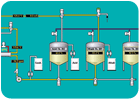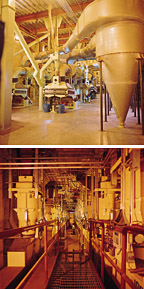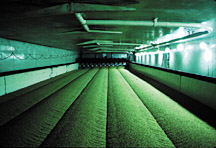Technology Update: SCADA evolves toward MES

In Food Engineering's 2001 Best Manufacturing Practices Survey (Feb., '01), only five percent of respondents reported having SCADA systems in their plants.
We thought that surprisingly low. The problem may lie in the definition.
SCADA -- the acronym and abbreviation for Supervisory Control And Data Acquisition -- has become more difficult to define as these systems add more production-management and manufacturing-execution functions, blurring the distinction between SCADA and MES (Manufacturing Execution Systems).
The term SCADA emerged during the 1980s from the gas, oil and utilities industries, where it refers to remote monitoring and control of widely distributed plcs and I/O points in facilities such as oil fields, electric-power generating stations, water and wastewater-treatment plants. Eventually the term was applied in manufacturing plants to operator interfaces with processes directed by plcs. A typical SCADA system integrates plcs on the plant floor with a PC and might include some sort of man/machine interface (MMI).
Today, that integration increasingly includes HMI (human/machine interface), a PC with graphic process and machine-status displays, alarms, messages, diagnostics, data access, reporting tools and automated process execution, allowing operator feedback. "SCADA has become almost interchangeable with HMI," observes Mark Richman, automation engineer at systems integrator Tri-Core, Inc., Racine, Wis.
John Blanchard, principal analyst at the ARC Advisory Group (Dedham, Mass.), Sees two trends contributing to the growing functionality and upward evolution of HMI/SCADA systems. "First, the MMI (man/machine interface) market is flat -- anybody can do it. So the only way for the vendor to build his business is to take-on more functionality," Blanchard points out. "Second, by doing that, they're becoming more and more the interface to what's usually called the ERP systems. By definition, that becomes MES. So there's a business trend evolving here that puts them in the middle."
Process control & batch execution
Major software vendors today offer turnkey HMI/SCADA systems, and systems integrators can either install turnkey solutions or customize systems integrating components from various vendors. Tri-Core, for example, can install complete HMI/SCADA packages from Rockwell, Intellution and Wonderware, or provide tailored solutions not available from any single vendor.In determining which type of system to install, "customer requirements are the first and foremost consideration," says Richman. "Cost is always a consideration. And where you're trying to control certain portions of a process, the project may not be big enough to support a full-blown HMI, so you'd probably put in something like a panelview or Quick Panel or some other type of OIT (operator interface terminal). The HMI is often used in a lab or office, but we put them in NEMA 4X enclosures (to resist washdown) on plant floors as well. So the basic considerations on any project are customer requirements, cost, and the complexity of the system."
One recent example of a Tri-Core HMI/SCADA project is the installation of a Rockwell rsview32 system at the Portion Pac, Inc. Plant in Mason, Ohio. Portion Pac, a unit of H.J. Heinz Co., Manufactures flexible and rigid single-serving packages of ketchup, salad dressings, sauces and other condiments for food-service markets. The plant operates three batch processes -- one for ketchup, one for salad dressings, and one for specialty condiments -- each controlled by a separate rsview program integrating four Allen-Bradley SLC 5/05s which govern each process from batching up to the filling machines. According to Richman, system architecture consists of a server PC and a client PC in the ketchup area with another client for the salad dressing operation, and a second client/server system for the specialty process, all linked via Ethernet.
"The former system was just mechanical relay logic, so there was no PLC control whatsoever," says Bob Lindhorst, plant engineer at Portion Pac. "Now there are a lot of visual aids on the screen for much better operator interface."
rsview controls recipe execution, batching, blending, heating, cooling, pasteurization, homogenization, pumps, valves, holding-tank levels and CIP, Lindhorst continues. Process variables such as pressure are controlled to minimize pump wear and reduce maintenance. "We can build recipes now; we couldn't do that before," he adds. "You just click the recipe and everything is automatic." Because the programs for all three manufacturing areas are connected via Ethernet, any process can be monitored and controlled if necessary from any station.
Rockwell describes rsview32 as "an integrated, component-based HMI software package for monitoring and controlling automated machines and processes." The system incorporates open technologies for connectivity with other Rockwell products, Microsoft products and third-party applications. "I would say that SCADA is a subset of today's standard control systems," says Darryl Walther, rsview32 product manager at Rockwell Automation (Milwaukee, Wis.)
Standards ease integration
The latest HMI/SCADA releases from major vendors are based on Windows NT, '95 or 2000 operating systems and embed Microsoft object technology standards (which minimize the time required to customize software to specific applications); open client/server standards (which allow integration with devices from multiple vendors); and web-based tools for integrating with upper-level business systems and throughout the enterprise. Major standards include:
- OLE (Object Linking & Embedding);
- OPC (OLE for Process Control), a client/server standard for communicating with devices from multiple vendors;
- activex, Microsoft Component Object Model (COM) controls which allow sharing objects with larger programs or applications (called containers);
- VBA (Visual Basic for Applications), a programming language for customizing applications;
- ODBC (Open Data Base Connectivity) to integrate with relational databases via SQL (Structured Query Language);
- SQL Server, Microsoft's relational database.
All of these technologies are included in Windows DNA-M (Distributed internet Applications for Manufacturing), which links "islands of information" within a manufacturing environment and "bridges the gaps" between enterprise applications and supply-chain partners.
Several vendors have added "thin client" technology, which allows any client computer to access a SCADA (or other systems) residing on a central server for real-time access to HMI information throughout the enterprise. In other words, the HMI/SCADA software need not reside in client computers for a client to access all the functionality of the server.
Upgrades & applications
Among the HMI/SCADA systems which incorporate these technologies and more are Rockwell's rsview32, Intellution's ifix, Wonderware's intouch , Ci Technologies' Citect, National Instrument Corporations' Lookout and Fisher-Rosemount's deltav.Intellution (Foxborough, Mass.) On Feb. 12 released ifix 2.5, the latest HMI/SCADA solution in its Dynamics family of automation solutions. The upgrade operates on Windows 2000 as well as NT and incorporates i clientts thin-server technology.
Dynamics, including FIX HMI/SCADA and visualbatch packages, integrates with other systems incorporating Microsoft DNA-M standards throughout Ocean Spray Cranberries Co. To empower operators making value-added on-line decisions and linking plant-floor automation with an SAP ERP system. As reported in Food Engineering's 1999 "New Plant Of The Year" feature (June, '99), process control at the Hunt-Wesson Snack Pack Pudding plant in Waterloo, Iowa, consists of Allen-Bradley plcs, Intellution FIX and visualbatch software networked via Ethernet into a SCADA system.
deltav, the HMI/SCADA component of Fisher-Rosemount's plantweb field-based solution, offers software options for data acquisition, calculations, sequencing, regulatory control and batch. In addition to OLE and OPC, deltav supports Foundation fieldbus and HART communications standards. Currently, Arancia Corn products is installing plantweb at its corn wet-milling plant in San Juan del Rio, Mexico, which produces glucose, dextrose and high-fructose corn syrup. In January, the Danish seafood packer Maritex selected plantweb for automating a new fish process at its plant in Vesteralen, Norway, north of the Arctic Circle. Fisher-Rosemount is based in Austin, TX,
Wonderware's intouch Version 7.1, the HMI/SCADA upgrade to Wonderware's factorysuite 2000 manufacturing-management information system, can also be accessed via thin-client technology and adds Internet integration to the plant floor, allowing execution of existing applications or design of Internet-specific applications. Tim Sowell, Wonderware's director of marketing for factorysuite, concurs with ARC's John Blanchard about the evolution SCADA toward the MES level. Wonderware ( Irvine, Cal.) Perceived in the mid-'90s that people wanted more out of SCADA than supervisory control and data acquisition, says Sowell. "They want data stored for longer periods of time, faster rates, larger volumes, uptime and downtime reports," he continues. "People want to do benchmarking, discrete tracking and a whole lot more with plant data. If you consider what we have to offer today, the traditional SCADA has become a commodity."

SIDEBAR 1 :
HMI/SCADA automates coffee-bean process
Lookout, a Windows NT-based HMI/SCADA software package from National Instruments Corp. (Austin, Tex.), Automates batch processing, recipe management, reporting and statistical process control (SPC) of coffee-bean blends while integrating with inventory management at Silocaf of New Orleans.Silocaf, a unit of the Italian firm Pacorini Finanziaria S.p.A., Processes more than 550 million lbs. Of green coffee per year for major U.S. coffee marketers, accounting for about one-third of all U.S. coffee imports and a market value of $885 million.
The core of our operation is the batching system for blend production. Because coffee is a natural product and certain supplies are seasonal, consistency of blend flavors is difficult to maintain. We therefore offer customers the ability to blend coffee from different origins. We can achieve the desired consistencies only through accurate and complex mixing.
In the early '90s, when we renovated a public grain elevator at the Port of New Orleans into a coffee-processing plant, we installed bulk-handling equipment including bucket elevators, chain-drag conveyors, bulk weighing systems, screening machines and aspiration channels to move, weigh and remove foreign material from coffee beans. By the end of 1996, we felt the need for a new supervisory control and data acquisition (SCADA) system which could meet the following criteria:
- Exceptional recipe management, to produce custom blends;
- Batch reports to match custom billing needs;
- SPC control of batch processing to a blend accuracy of 0.5 percent;
- Integration with our inventory management system, enabling us juggle inventories from a dozen different countries to meet custom batch requirements.
More general criteria included networking, computer redundancy, integration with a variety of plcs, and the ability to modify our software configuration on-line during batch production.
Lookout met these requirements and offered additional benefits. Lookout's object architecture, for example, allowed us to configure the software to our application in less time than we expected. National Instruments also releases new seamless upgrades every few months, allowing continuous improvement.
Our entire plant is monitored and controlled by Lookout. Screen graphics symbolize and color-code the status of nearly 300 devices. More than 1,500 alarms alert operators to the status of any process in real time.
Three of the Lookout stations communicate over their own subnet in an NT Server LAN, which isolates the control system from the rest of the plant. One station acts as a server, communicating with the plcs and more than 5,300 I/O points over a local Tiway network. Operators at any client station can monitor and control the entire process. Redundancy allows one station to stand-by and take-over communication with the plcs should a fault occur in the primary server. When not acting as a server, the stand-by unit functions as a client.
The batching system consists of 52 automatic bulk-weighing scales, of which up to 24 can operate simultaneously. Lookout monitors and controls this system by communicating with several Siemens plcs.
Full integration of production information with our inventory-management system was achieved through object standards such as OPC and ODPC. As newer technologies emerge, SCADA systems continue to evolve.
Edited from a report by Massimo D'Attoma, Systems & Resources Manager, Silocaf of New Orleans, Inc.

SIDEBAR 2
SCADA boosts malt quality & throughput
A Citect SCADA system supplied by Ci Technologies (Sydney, NSW) helped boost annual malt production from 20,000 metric tons after startup in 1978 to 46,000 tons today at the five-hectare Kirin Australia plant, a malting unit of Japan's Kirin Brewery at Welshpool, Western Australia (near Perth).Kirin in 1995 decided to replace its existing Unix-based SCADA system with Windows-based client/server Citect software packages to achieve more accurate monitoring and control of its malting operation. Stage 1 of the project involved upgrading controls for the steeping and germination processes. Stage 2 continued the project by programming existing plcs to control barley receiving, barley cleaning, dry-hopper filling, malt cleaning and malt outloading, and replacing the existing SCADA with a Citect system consisting of two redundant workstations in the control room plus two field workstations, one at barley receiving and another at malt outloading. Stage 3 upgraded control of the kilning process.
According to cit, the Kirin technical staff reported "marked improvement in supervision and control of all essential variables." Additional improvements
include remote monitoring and acknowledgement of alarms in unmanned areas; centralized production information, allowing better access and use of the information; improved inventory control and management.
According to Graig Adams of systems integrator PCT (Perth), which executed stage 2 of the project, Citect was installed to communicate with the existing Modicon plcs, "providing a 'window' into the plcs." Temperature and humidity were among the variables improved to encourage barley germination. Citect improved screen graphics and dramatically reduced screen-information update time from 29 seconds to less than two seconds, Adams added.
The Kirin plant is currently upgrading its Citect systems from Version 4 to Version 5, released last year. Standard features include OPC client/server architecture, ODBC (Open Database Connectivity), SPC, Circode high-level SCADA programming language, and up to 170 device drivers for I/O communications and "capable of integrating with plcs from just about any other vendor," says Brian Preston, marketing coordinator for Ci Technologies, Inc. (Charlotte, N.C.). On Dec. 20, cit released Citect Version 5.30, which features activex object support, alarm filtering to define alarms by user criteria, and remote I/O enhancements.
Looking for a reprint of this article?
From high-res PDFs to custom plaques, order your copy today!




